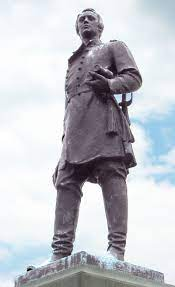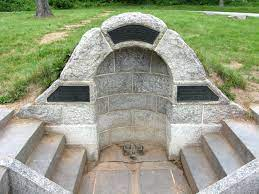No battle of the Civil War has captured the popular imagination more than the three-day affair at Gettysburg (July 1-3). As the quintessential battle of the War Between the States, if not American history in general, thousands of participants and contemporary writers were eager to maximize the drama through incredible or moving stories. Commanding officers were keen to enhance or restore their reputations and often sought to tear down others’. As a result, the events at Gettysburg have given rise to plenty of myths, most of which were credulously (though sometimes understandably) reported as fact by historians and documentarians.
#1:
The Confederates Came to Gettysburg for Shoes
The story is that divisional commander General Henry Heth heard of a shoe factory in Gettysburg. Desperate to find footwear for the bare feet of his soldiers, he ordered a force towards the town for this express purpose. Thus the greatest battle of the Civil War began over shoes. This is a nice story showing how simple causes can lead to massive effects. However, Heth’s report states that he ordered his men into town to find all manners of supplies, shoes included. He added “especially shoes” because, for men marching hundreds of miles, exposed feet were a major concern. The Confederates would have had to scour the shops or try to take from civilians to find them, because Gettysburg in fact had no shoe factory.
#2:
The Dutch Run Again
 |
| Statue of Francis Barlow at Gettysburg |
Throughout July 1 the Union Army sent reinforcements north of Gettysburg to form a line and meet the also gradually expanding Confederate force. The defensive line, which had been holding up nicely, finally came undone when the German immigrants of the XI Corps panicked and fled, enabling the Confederates to unravel it and send the Unions running through town. The Germans, or “Dutch,” ran just like they did at Chancellorsville when Stonewall Jackson had marched into their flank. It was not cowardice that lost the first day of Gettysburg, however. It was in fact a tactical blunder on the part of General Francis Barlow, a divisional commander. Instead of connecting his left flank with Carl Schurz’s division, he advanced to the height of Blocher’s Knoll so the enemy could not use it. What resulted was an overextended salient which the Confederates were able to break through. The largely German XI Corps had no choice but to retreat with Confederates pouring into their right flank. Some critics also (more incorrectly) claimed that these men almost lost Cemetery Hill on July 2 by running again.
#3:
Longstreet Was Blameless at Gettysburg
The myth that Longstreet was solely to blame for the Confederate defeat at Gettysburg has been effectively debunked. Lee’s decision to assault a numerically superior foe on good ground was a questionable decision. This has led many to describe Longstreet as a modern general who, if listened to, would have enabled Confederate success in the summer of 1863. While his strategic vision was better than Lee’s, Longstreet shares some blame for the defeat, particularly on the second day. His initial delays in preparing his troops to attack and roll up the Federal left were approved by Lee thanks to circumstantial difficulties. Longstreet was still to launch his attack at 11 AM. Instead, thanks to his lack of enthusiasm, he mismanaged his troop movements and caused what many historians consider a “comedy of errors.” When he finally attacked it was 4 PM and there were much more Federals in the area to prevent any decisive breakthrough. While he was likely right about what course Lee should have taken, Longstreet let his frustration impede his judgment and prevent possible success.
#4:
The Sharpshooters at Devil’s Den
 |
| This famous (staged) photo of a dead Confederate at a perch for firing further associated Devil's Den with the sharpshooters |
During the fighting for Little Round Top on the Union left, Confederates in and around Devil’s Den took to sharpshooting. Showing the power of the modern rifle, they wreaked havoc on the Federals, killing and wounding many with deadly accuracy. Among their victims were General Weed and Lieutenant Charles Hazlett, killed within moments of each other. Surely this proved the overwhelming superiority of the Civil War rifle. The sharpshooters certainly dealt damage, but how they did so is misunderstood. As explained in Scott Hippensteel’s Myths of the Civil War, sharpshooters were good shots, but not snipers. When going for faraway targets such as Little Round Top, they would group their fire, sending multiple bullets flying around favorite targets such as artillery crews or officers. The rifles were not as accurate over such distances as many like to say. Weed and Hazlett died in close time and proximity because such a concentration was thrown in their direction.
#5:
The 20th Maine Saved the Union at Little Round Top
 |
| Chamberlain at Little Round Top is a favorite subject for artists. This comes from Mort Kunstler. |
Thanks to Michael Shaara’s Killer Angels and its film adaptation (Gettysburg), most Americans believe that Colonel Joshua Lawrence Chamberlain and the 20th Maine saved the critical left flank at Little Round Top and thus the battle by extension. They certainly had a hot fight and a defeat would have caused trouble for the Army of the Potomac. What many do not realize is that the Confederates would have found it difficult to hang on to their capture, much less exploit it. The 15th Alabama, which assaulted the Mainers, did not have any great numerical superiority, even when men from the regiment on their left joined them. If successful, they would have had to wait for reinforcements. By then the Federals could have retaken Little Round Top, as they had plenty of men still marching to the battlefield. It should also be noted that a similar desperate fight unfolded later that evening on Culp’s Hill. There the Union right, stripped of men to meet emergencies at the center and left, found itself assailed by greater numbers. Arguably a Confederate success here would have been far more damaging.
#6: Meade Was Not Instrumental in the
Union Victory
Meade constantly gets overlooked in popular narrative of Gettysburg and when he is mentioned it’s sometimes in an unflattering light. His near-absence in Killer Angels and film adaptation are indicative of this, as if he had no key role in winning the battle. Instead people credited II Corps commander General Winfield Hancock or emphasized Confederate mistakes. Some of Meade’s professional enemies spread a rumor that he wanted to retreat after the second day, while others maintained that he was distressed because he was not able to fight at his chosen ground of Pipe Creek. Historians have gone a long way in restoring his place in history. Meade in fact rose to the challenge. Though he was too far away to conduct the battle on the first day, he was very much active on the second. As crises unfolded along his line, he skillfully selected and forwarded reinforcements from all points in his line. These reinforcements consistently halted the Confederates when a breakthrough looked imminent. Meade also predicted that Lee would strike his center on the third day (one account, possibly apocryphal, claims that he called it the safest part of the line). Meade’s leadership was instrumental in securing the first massive Union victory in the East. He outgeneraled Lee, who on this occasion failed to ensure that his subordinates acted cohesively.
#7: The Camaraderie at Spangler Spring
 |
| This Spangler Spring Memorial emphasizes the shared experience of Union and Confederate soldiers. |
Soldiers from both sides went to Spangler Spring, south of Culp’s Hill, to fill their canteens. Amidst all the death and carnage about them, they agreed to a truce and, like friends rather than enemies, socialized as they got their water. This is a heartwarming tale, but the reality is more awkward. Several accounts have soldiers coming to the spring, only to backtrack when they saw that their foes were already there. The closest that Federals and Confederates got to interacting was when the 2nd Connecticut suddenly found themselves in line for water with a Confederate regiment. Realizing their situation, the two sides did not fight, but neither did they interact. They quietly got their water and separated, relieved that no fighting had broken out.
#8: Stuart’s Cavalry had a Vital Role in
Pickett’s Charge
A few historians, as well as those looking for exciting new ways of looking at the battle, have talked about the battle of the East Cavalry Field, 3 miles east of Cemetery Ridge. While several infantry divisions assaulted the Union center on the ridge, Stuart was to lead his cavalry corps into the enemy rear. This also makes the Federal cavalry, which confronted and battled their opposing counterparts, look more heroic and important. Battle reports show that this was simply not the case. Lee sent Stuart around to the east in case the Confederate left flank was threatened. As far as Pickett’s Charge goes, Stuart was told to be ready to cut into Union lines of communication and supply to maximize the effect of a breakthrough. This of course did not happen.
#9:
Meade Missed an Opportunity to Destroy Lee’s Army on July 3-4
Despite winning one of the largest battles of the war, Meade let Lee slip away from Gettysburg. This fits into the narrative where the aggressive Grant finally wins the war by taking personal control of Union forces in Virginia, and unfairly lumps Meade in with his failed predecessors. People often mistakenly think that winning a defensive battle means one can then switch right over to the attack. The reality is that the Battle of Gettysburg was just as telling on the victors. Many soldiers were fought out, wounded, or had not had food or healthy drinking water for days. Dozens of officers had been killed or wounded, while units were badly mixed up after all the movements of the second day. The army simply did not have the organization for a proper attack.
#10:
Meade Did Not Effectively Pursue Lee
 |
| Edwin Forbes Illustration of Confederate earthworks at the Potomac |
Similar
accusations concerned Meade’s pursuit of Lee. He was accused of being overly
cautious. The same factors that restrained him at Gettysburg also made it hard
to start such a pursuit. Union cavalry effectively harassed the retreating
Confederates while the rest of the army organized. Thanks to a swollen Potomac
River Meade was able to catch up to Lee. Meade was likewise castigated for not attacking
the Confederates while they were trapped on the northern side of the river.
However Meade was not sure about attacking what seemed to be formidable
entrenchments. He did order an advance, but the enemy escaped on a pontoon
bridge. According to General Henry Hunt, the intelligent Chief of Artillery, the
abandoned earthworks he walked into confirmed that an attack would have been
hard, perhaps disastrous, for Meade’s men. Lee evidently though so, having been
very eager to reverse the roles at Pickett’s Charge.





No comments:
Post a Comment